|
A moving ship generates a wake which consists of a characteristic wave
pattern in a V-shaped region behind the ship (Kelvin wake), and a turbulent
wake along the track of the ship. Such a ship wake can often be seen in images
acquired by the optical sensor aboard the SPOT
satellites or by the
synthetic aperture radar (SAR) aboard
the
ERS-1 and ERS-2 satellites
(and RADARSAT).
|
What is a ship wake?
A moving ship (or any other object moving at or near the water surface)
generates a kind of trace on the water surface which is called a wake.
Around and directly behind the ship, the wake is rather complex, with
so-called bow and stern waves, eddies and currents, and foam. It depends on the
actual shape of the ship, the ship's screws, and the ship speed, among other factors.
From about 3 ship lengths behind the ship, the main features of the ship wake
are rather universal and do not depend much on the shape of the ship or the
screws.
Here, the ship wake is a combination of two different phenomena:
- the turbulent wake, i.e., foam, turbulent water and
sometimes
surface films in the ship's track
- the Kelvin wake, i.e. a characteristic wave pattern
behind the ship (named after Lord
Kelvin who first explained the physics of ship wakes in 1887).
In shallow water, which in this context is defined by
 (V: ship speed, D: water depth, g: acceleration of
gravity), there is only a fan-shaped wave pattern
("divergent waves"), see image below.
The opening angle of this wedge-shaped wave
region depends on the ship speed.
(V: ship speed, D: water depth, g: acceleration of
gravity), there is only a fan-shaped wave pattern
("divergent waves"), see image below.
The opening angle of this wedge-shaped wave
region depends on the ship speed.
At the outer edges of this wedge, the waves are often highest; the
edge is called "cusp line" or "Kelvin arm"
For a typical ship speed of 10 m/s (20 knots), "shallow"
as defined above means a depth of less than 5.6 m. Since the water
depth along shipping lanes in the sea is usually 10 m or more, the
case of shallow water is rare, except for speed boats.
|
(V: ship speed, D: water depth, g: acceleration of
gravity), the wave pattern of the Kelvin wake consists of two
kinds of waves: transverse waves (crests across the ship's track) and
divergent waves
(crests roughly parallel to the ship's track, moving outward).
They are confined to a wedge-shaped region behind the ship, and the half
angle of that wedge is 19.5°, independent of the ship's
speed, as long as the deep water condition is satisfied.
For a typical ship speed of 10 m/s (20 knots), "deep"
as defined above means a depth of more than 5.6 m. Since the water
depth along shipping lanes in the sea is usually 10 m or more, the
water can usually be considered deep for most ships except speed boats.
|

|
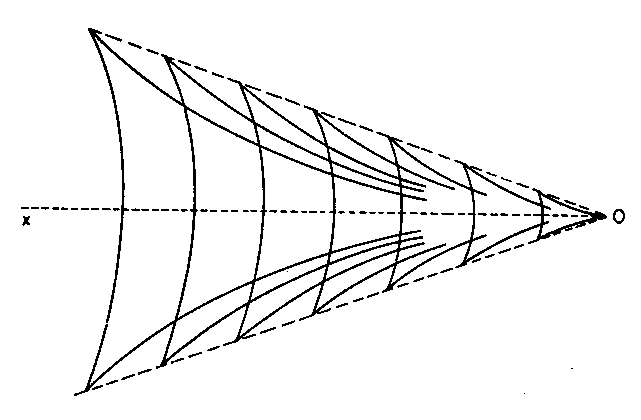
|
Thus, wakes of ships on the sea will have the following general appearance
:

The length of the longest waves in the Kelvin wake is between about 15 and
60 m for typical ship speeds between 5 and 10 m/s.
|
Imaging of Ships by the Synthetic Aperture Radar of the ERS Satellites
A synthetic aperture radar (SAR)
like the one carried by the ERS
satellites senses the roughness of the water surface. The more short-scale water
waves
there are, the more microwaves are backscattered to the SAR, and the brighter
the resulting SAR image looks.
Specifically, the SAR of ERS is sensitive to surface waves with a length of
about 6 to 8 cm; they are called "Bragg waves".
The Bragg waves are modified by a ship wake in several ways:
- The waves of the Kelvin wake modulate Bragg waves.
Thus the individual waves of the Kelvin
wake can become visible as alternating bright and dark lines,
provided their wavelength is greater than the spatial resolution of the SAR
(which is rare for ERS).
Otherwise, the cusp lines, where waves are usually highest, become visible
in the SAR image as slightly bright lines (the modulation, when averaged,
does not cancel. but is positive).
Modulation is strongest for waves
travelling in or opposite to the radar look direction.
- Bragg waves (and water waves in general) are damped by the turbulence in the turbulent wake
(i.e. the water surface is smoothened). Thus the turbulent wake becomes
visible in the SAR image as a dark line that marks the ship's track
- In very calm conditions, the eddies and currents in the turbulent wake
make it rougher than the surroundings. Then, the turbulent wake appears as
a bright line in a SAR image.
In addition, a ship itself is a strong radar reflector since it is made of metal
and has structures with right-angled corners. Therefore, a ship usually appears
as a bright dot in a SAR image.
Images: Kelvin Wakes
a
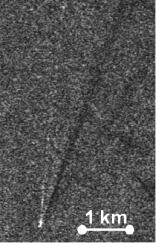
© ESA 1997
|
b
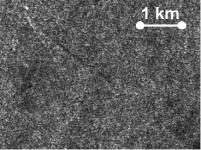
© ESA 1996
|
c
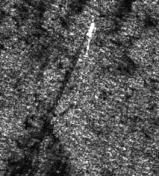
© ESA 1996
|
| ERS SAR images with slightly bright Kelvin arms of ship
wakes. Only one Kelvin arm is visible because the propagation direction of
the waves in the other arm is at right angles with the radar look
direction. In all three
images, a bright spot for the ship and dark turbulent wake are also visible. |
| (a) ERS-2, South of Singapore, 21 Oct 1997,
1544 GMT. Note that the whole sector between the Kelvin arm and
the dark turbulent wake is slightly brighter than the surroundings.
|
(b) ERS-2, Straits of Malacca, 25 Apr 1996,
0337 GMT.
Note that the whole sector between the Kelvin arm and
the dark turbulent wake is slightly brighter than the surroundings.
|
(c) ERS-1, South China Sea, 9 Apr 1996,
0307 GMT
|
Images: Turbulent Wakes
a
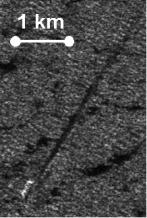
© ESA 1996
|
b
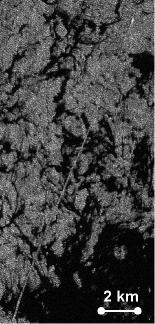
© ESA 1999
|
c
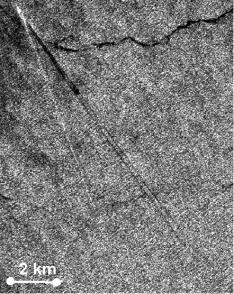
© ESA 1999
|
| ERS SAR images with turbulent wakes. In all three images,
a bright spot for the ship is also visible. |
| (a) ERS-2, Gulf of Thailand, 8 Apr 1996,
0338 GMT.
A typical dark turbulent wake.
|
(b) ERS-1, south China Sea, 9 Apr 1996,
0307 GMT.
A bright turbulent wake, particularly distinct where it crosses dark
patches that are caused by surface films (surface films smoothen the water
surface, this is looks dark in the image).The turbulence of the wake breaks
up the surface films, thus it looks brighter.
|
(c) ERS-1, Straits of Malacca, 4 May
1996, 1559 GMT.
A long turbulent wake that consists of two parallel dark lines
(resembling a "railroad"). Likely cause:
surface films gathered convergent surface currents at the edge of the
turbulent wake. One bright Kelvin arm is also visible.
|
An investigation of about 400 ship wakes visible in ERS SAR images showed
the following occurrence frequencies of the various ship wake features:
- Bright dot for ship: always
- Kelvin wake/arm: 1/6 of all cases
- turbulent wake: always:
- dark: 1/2 of all cases
- bright: 1/3 of all cases
- dark and bright: 1/6 of all cases
|
Imaging of Ships by the Optical Sensors of the SPOT Satellites
The imaging of ship wakes by the optical sensor
(HRV) of the
SPOT satellites
is governed by the effect of "sun glitter", i.e. the direct
reflection of sunlight by the sea surface into the sensor.
Any tilt of the water surface by waves (e.g. waves of the Kelvin wake,
small-scale ripples) influences the sun glitter.
Depending on the position of the sun and the sensor, there are two possible
cases for the waves of the Kelvin wake:
| Case 1: waves of the wake cause sun glitter,
whereas the surrounding water surface does not |
Case 2: surrounding water surface causes sun glitter,
but the waves of the wake do not |
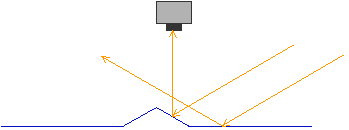
|
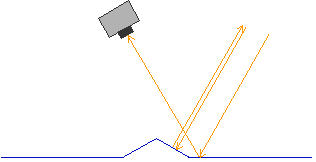
|
The individual waves of the Kelvin wake or the cusp lines can therefore appear
dark or bright in a SPOT image.
Similar considerations apply for the turbulent wake:
Because water waves are damped by turbulence, there are fewer or smaller waves
in the turbulent wake. Depending the the position of the sun and the sensor,
this can mean more or less sun glitter, so the turbulent wake can be a dark or a
bright line.
The ship itself is usually not very prominent in SPOT images, but the foam
and white water around and directly behind the ship is often noticeably bright in
the image.
Images: Kelvin and Turbulent Wakes
a
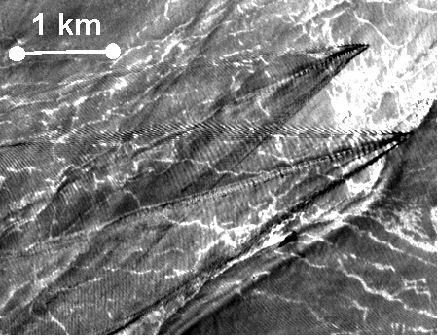
© CNES 1995
|
b

© CNES 1995
|
c
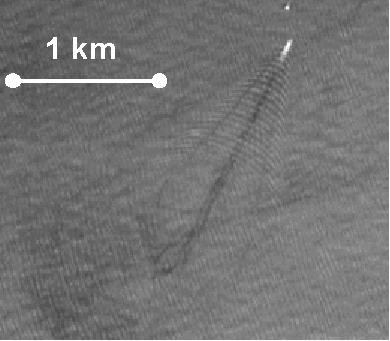
© CNES 1995
|
|
SPOT panchromatic images with Kelvin wakes. The transverse waves are
visible in all three images.
|
| (a)
Near Singapore, 18 Oct 1995, 0345 GMT. Transverse waves.
|
(b)
South of Singapore, 18 Oct 1995, 0345 GMT.
Transverse and divergent waves; the bright turbulent wake.
|
(c)
Near Brunei, 25 Oct 1995, 0309 GMT. Whitewater near ship;
transverse waves, dark turbulent wake.
|
In SPOT images, ship wakes can often be seen in more detail than in ERS
images because the spatial resolution of SPOT is higher (10 m
in panchromatic mode
vs. 25 m for ERS SAR). However, this requires favourable viewing
conditions, especially cloud-free skies.
|
Conclusion
Ship wakes are imaged by ERS SAR and SPOT because they generate and modify
surface waves. The turbulent wake is almost always visible on ERS SAR and SPOT
images as a dark or bright line. The individual waves of the Kelvin wake are
rarely seen on ERS SAR images since the resolution is not sufficient in most
cases, in panchromatic SPOT images they are more often imaged due to the higher
resolution. Imaging of the cusp lines by ERS SAR strongly depends on the
propagation direction and the amplitude of the cusp waves, therefore they are
often invisible. The ship's backscatter is always very conspicuous in ERS SAR
images of the sea. In order to monitor ship traffic, SAR is better suited than
optical sensors, since it can penetrate clouds and does not depend on sunlight. In
particular, the turbulent wake and the ship's backscatter are the features to be
used for detecting ships.
|
Christian Melsheimer (crscm@nus.edu.sg)
|













